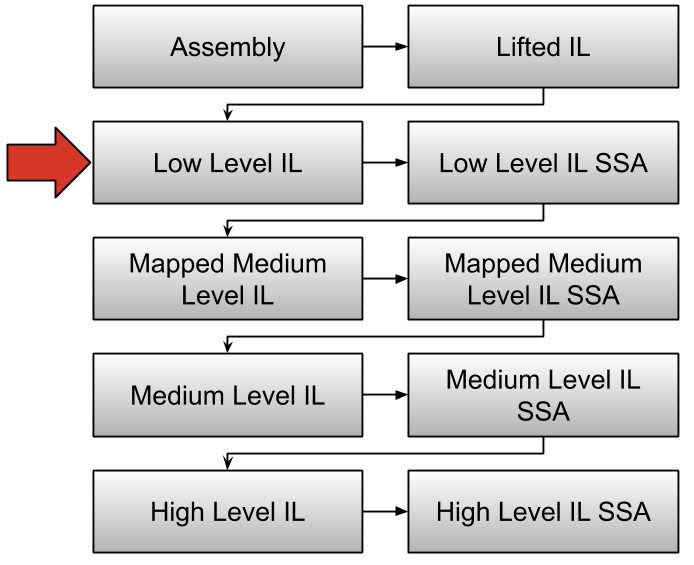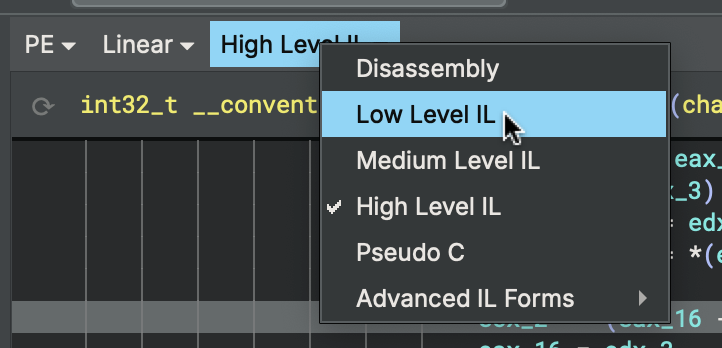Binary Ninja Intermediate Language: Low Level IL¶
Make sure to checkout the BNIL overview first if you haven't already. Or feel free to skip to part 2 which covers MLIL, or part 3 which covers HLIL. This developer guide is intended to cover some mechanics of LLIL to distinguish it from the other ILs in the BNIL family.
If you've already read the introduction, let's get right into the details of LLIL!
The Lifted IL is very similar to the LLIL and is primarily of interest for Architecture plugin authors. If you're writing an analysis plugin, you'll always want to be working at LLIL or higher. During each stage of the lifting process a number of transformations take place, and each layer of IL can have different instructions. Because of this, you can not rely on an instruction from one layer existing in another.
Introduction by example¶
Since doing is the easiest way to learn let's start with a simple example binary and step through analyzing it using the python console.
- Download chal1 and open it with Binary Ninja
- Next, bring up the
Low Level ILview by clicking in the view drop down at the top of the pane (or alternatively, use theikey to cycle view levels) - Navigate to main (
g, then "main", or double-click it in the function list) - Finally, bring up the python console using:
~
Next, enter the following in the console:
>>> for block in current_function.low_level_il:
... for instr in block:
... print (instr.address, instr.instr_index, instr)
...
4196422 0 push(rbp)
4196423 1 rbp = rsp {var_8}
4196426 2 rsp = rsp - 0x110
4196433 3 rax = rbp - 0xc0 {var_c8}
...
This will print out all the LLIL instructions in the current function. How does this code work?
First we use the global magic variable current_function which gives us the python object function.Function for whatever function is currently selected in the UI. The variable is only usable from the python console, and shouldn't be used for headless plugins. In a script you can either use the function that was passed in if you registered your plugin to handle functions, or you can compute the function based on a specific address, or maybe even just iterate over all the functions in a BinaryView (for func in bv.functions:).
Next we get the lowlevelil.LowLevelILFunction from the Function class: current_function.low_level_il. Iterating over the LowLevelILFunction class provides access to the lowlevelil.LowLevelILBasicBlock classes for this function. Inside the loop we can now iterate over the LowLevelILBasicBlock class which provides access to the individual lowlevelil.LowLevelILInstruction classes.
Finally, we can print out the attributes of the instruction. We first print out address which is the address of the corresponding assembly language instruction. Next, we print the instr_index, this you can think of as the address of the IL instruction. Since translating assembly language is a many-to-many relationship, we may see multiple IL instructions needed to represent a single assembly language instruction, and thus each IL instruction needs to have its own index separate from its address. Finally, we print out the instruction text.
In python, iterating over a class is a distinct operation from subscripting. This separation is used in the LowLevelILFunction class. If you iterate over a LowLevelILFunction you get a list of LowLevelILBasicBlocks, however if you subscript a LowLevelILFunction you actually get the LowLevelILInstruction whose instr_index corresponds to the subscript:
>>> list(current_function.low_level_il)
[<block: x86_64@0x0-0x3f>, <block: x86_64@0x3f-0x45>, <block: x86_64@0x45-0x47>,
<block: x86_64@0x47-0x53>, <block: x86_64@0x53-0x57>, <block: x86_64@0x57-0x5a>]
>>> type(current_function.low_level_il[0])
<class 'binaryninja.lowlevelil.LowLevelILInstruction'>
>>> current_function.low_level_il[0]
<il: push(rbp)>
Low Level IL Instructions¶
Now that we've established how to access LLIL Functions, Blocks, and Instructions, let's focus in on the instructions themselves. LLIL instructions are infinite length and structured as an expression tree. An expression tree means that instruction operands can be composed of operation. Thus, we can have an IL instruction like this:
eax = eax + ecx * 4
The tree for such an instruction would look like:
=
/ \
eax +
/ \
eax *
/ \
ecx 4
Now let's get back to the examples. First let's pick an instruction to work with:
>>> instr = current_function.low_level_il[2]
>>> instr
<il: rsp = rsp - 0x110>
For the above instruction, we have a few operations we can perform:
- address - returns the virtual address
>>> hex(instr.address)
'0x40084aL'
- function - returns the containing function
>>> instr.function
<binaryninja.lowlevelil.LowLevelILFunction object at 0x111c79810>
- instr_index - returns the LLIL index
>>> instr.instr_index
2
- operands - returns a list of all operands.
>>> instr.operands
['rsp', <il: rsp - 0x110>]
- operation - returns the enumeration value of the current operation
>>> instr.operation
<LowLevelILOperation.LLIL_SET_REG: 1>
- src - returns the source operand
>>> instr.src
<il: rsp - 0x110>
- dest - returns the destination operand
>>> instr.dest
'rsp'
- size - returns the size of the operation in bytes (in this case we have an 8 byte assignment)
>>> instr.size
8L
Now with some knowledge of the LowLevelIL class let's try to do something with it. Let's say our goal is to find all the times the register rdx is written to in the current function. This code is straight forward:
>>> for block in current_function.low_level_il:
... for instr in block:
... if instr.operation == LowLevelILOperation.LLIL_SET_REG and instr.dest.name == 'rdx':
... print (instr.address, instr.instr_index, instr)
...
4196490 14 rdx = [rax].q
4196500 16 rdx = [rax + 8].q
4196511 18 rdx = [rax + 0x10].q
4196522 20 rdx = [rax + 0x18].q
4196533 22 rdx = [rax + 0x20].q
4196544 24 rdx = [rax + 0x28].q
4196798 77 rdx = [0x602090].q
The Instructions¶
Going into gross detail on all the instructions is out of scope of this article, but we'll go over the different instructions types and speak generally about how they are used.
Registers, Constants & Flags¶
When parsing an instruction tree the terminals are registers, constants and flags. This provides the basis from which all instructions are built.
LLIL_REG- A register, terminalLLIL_CONST- A constant integer value, terminalLLIL_SET_REG- Sets a register to the results of the IL operation insrcattribute.LLIL_SET_REG_SPLIT- Uses a pair of registers as one double sized register, setting both registers at once.LLIL_SET_FLAG- Sets the specified flag to the IL operation insrcattribute.
Memory Load & Store¶
Reading and writing memory is accomplished through the following instructions.
LLIL_LOAD- Load a value from memory.LLIL_STORE- Store a value to memory.LLIL_PUSH- Store value to stack; adjusting stack pointer bysizeof(value)after the store.LLIL_POP- Load value from stack; adjusting stack pointer bysizeof(value)after the store.
Control Flow & Conditionals¶
Control flow transferring- and comparison instructions are straightforward enough, but one instruction that deserves more attention is the if instruction. To understand the if instruction we need to first understand the concept of labels.
Labels function much like they do in C code. They can be put anywhere in the emitted IL and serve as a destination for the if and goto instructions. Labels are required because one assembly language instruction can translate to multiple IL instructions, and you need to be able to branch to any of the emitted IL instructions. Let's consider the following x86 instruction cmove (Conditional move if equal flag is set):
test eax, eax
cmove eax, ebx
To translate this instruction to IL we have to first create true and false labels. Then we emit the if instruction, passing it the proper conditional and labels. Next we emit the true label, then we emit the set register instruction and a goto false label instruction. This results in the following output:
0 @ 00000002 if (eax == 0) then 1 else 3
1 @ 00000002 eax = ebx
2 @ 00000002 goto 3
As you can see from the above code, labels are really just used internally and aren't explicitly marked. In addition to if and goto, the jump_to IL instruction is the only other instruction that operates on labels. The rest of the IL control flow instructions operate on addresses rather than labels, much like actual assembly language instructions. Note that an architecture plugin author should not be emitting jump_to IL instructions as those are generated by the analysis automatically.
LLIL_JUMP- Branch execution to the result of the IL operation.LLIL_JUMP_TO- Jump table construct, contains an expression and list of possible targets.LLIL_CALL- Branch execution to the result of the IL operation.LLIL_RET- Return execution to the caller.LLIL_NORET- Instruction emitted automatically after syscall or call instruction which cause the program to terminate.LLIL_SYSCALL- System call instructionLLIL_TAILCALL- This instruction calls the expressiondestusingparamsas input andoutputfor return valuesLLIL_IF-Ifprovides conditional execution. If condition is true execution branches to the true label and false label otherwise.LLIL_GOTO-Gotois used to branch to an IL label, this is different from jump since jump can only jump to addresses.LLIL_FLAG_COND- Returns the flag condition expression for the specified flag condition.LLIL_CMP_E- equalityLLIL_CMP_NE- not equalLLIL_CMP_SLT- signed less thanLLIL_CMP_ULT- unsigned less thanLLIL_CMP_SLE- signed less than or equalLLIL_CMP_ULE- unsigned less than or equalLLIL_CMP_SGE- signed greater than or equalLLIL_CMP_UGE- unsigned greater than or equalLLIL_CMP_SGT- signed greater thanLLIL_CMP_UGT- unsigned greater than
The Arithmetic & Logical Instructions¶
LLIL implements the most common arithmetic as well as a host of more complicated instruction which make translating from assembly much easier. Most arithmetic and logical instruction contain left and right attributes which can themselves be other IL instructions.
The double precision instruction multiply, divide, modulus instructions are particularly helpful for instruction sets like x86 whose output/input can be double the size of the input/output.
LLIL_ADD- AddLLIL_ADC- Add with carryLLIL_SUB- SubtractLLIL_SBB- Subtract with borrowLLIL_AND- Bitwise andLLIL_OR- Bitwise orLLIL_XOR- Exclusive orLLIL_LSL- Logical shift leftLLIL_LSR- Logical shift rightLLIL_ASR- Arithmetic shift rightLLIL_ROL- Rotate leftLLIL_RLC- Rotate left with carryLLIL_ROR- Rotate rightLLIL_RRC- Rotate right with carryLLIL_MUL- Multiply single precisionLLIL_MULU_DP- Unsigned multiply double precisionLLIL_MULS_DP- Signed multiply double precisionLLIL_DIVU- Unsigned divide single precisionLLIL_DIVU_DP- Unsigned divide double precisionLLIL_DIVS- Signed divide single precisionLLIL_DIVS_DP- Signed divide double precisionLLIL_MODU- Unsigned modulus single precisionLLIL_MODU_DP- Unsigned modulus double precisionLLIL_MODS- Signed modulus single precisionLLIL_MODS_DP- Signed modulus double precisionLLIL_NEG- Sign negationLLIL_NOT- Bitwise complementLLIL_TEST_BIT- Test if bitrightin expressionleftis setLLIL_BOOL_TO_INT- Converts a boolsrcto an integer
Floating Point Operations¶
LLIL_FLOAT_CONST- Floating point constant valueLLIL_FADD- Floating point addLLIL_FSUB- Floating point subtractionLLIL_FMUL- Floating point multiplicationLLIL_FDIV- Floating point divisionLLIL_FSQRT- Floating point square rootLLIL_FNEG- Floating point negateLLIL_FABS- Floating point absolute valueLLIL_FLOAT_TO_INT- Floating point convert a floating point to an integerLLIL_INT_TO_FLOAT- Floating point convert an integer to a floating pointLLIL_FLOAT_CONV-LLIL_ROUND_TO_INT- Rounds to the nearest integerLLIL_FLOOR- Returns the floor of a floating point valueLLIL_CEILING- Returns the ceiling of a floating point valueLLIL_FTRUNC- Computes the floating point truncation of the IEEE754 number insrc
Floating Point Conditionals¶
These are identical to their native counterparts but are lifted separately so that the operations can impact different flags. See Control Flow & Conditionals above.
LLIL_FCMP_E- See aboveLLIL_FCMP_NE- See aboveLLIL_FCMP_LT- See aboveLLIL_FCMP_LE- See aboveLLIL_FCMP_GE- See aboveLLIL_FCMP_GT- See aboveLLIL_FCMP_O- See aboveLLIL_FCMP_UO- See above
Special instructions¶
The rest of the instructions are pretty much self-explanatory to anyone with familiarity with assembly languages.
LLIL_BP- Breakpoint instructionLLIL_EXTERN_PTR- A synthesized (fake) pointer to something which doesn't exist within the memory space of the current binaryLLIL_INTRINSIC- Intrinsics are operations withoutputandparamsand anintrinsicwhere the exact behavior is not modelled but the dataflow system can be improved by annotating the inputs and outputs. An example intrinsic would CPU AES instructions where the exact behavior is not modelled, but the inputs and outputs are.LLIL_INTRINSIC_SSA- SSA form of theLLIL_INTRINSICoperationLLIL_MEMORY_INTRINSIC_SSA- Memory versioning SSA form of theLLIL_INTRINSICoperationLLIL_NOP- No operationLLIL_SX- Sign extendLLIL_TRAP- Trap instructionLLIL_UNDEF- Undefined instructionLLIL_UNIMPL- Unimplemented instructionLLIL_UNIMPL_MEM- Unimplemented memory access instructionLLIL_ZX- Zero extendLLIL_MEM_PHI- A memoryPHIrepresents memory modifications that could have occured down different source basic blocks similar to aVAR_PHI.LLIL_LOW_PART-sizebytes from the low end ofsrcexpression
Currently Undocumented¶
LLIL_FLAG-LLIL_FLAG_BIT-LLIL_FLAG_GROUP-LLIL_FLAG_BIT_SSA-LLIL_FLAG_PHI-LLIL_FLAG_SSA-LLIL_TAILCALL_SSA-

